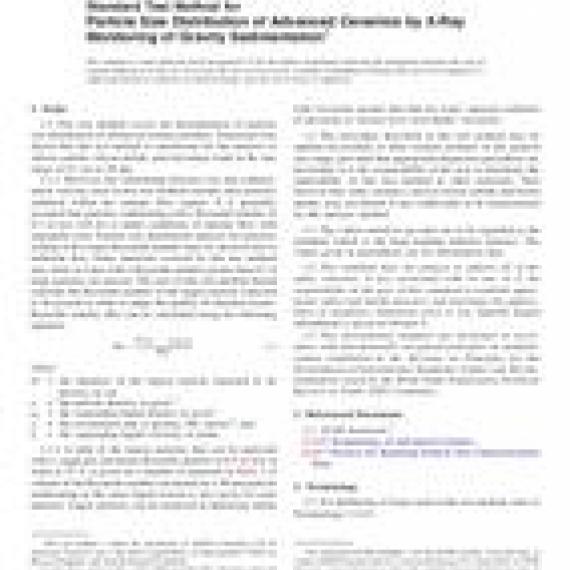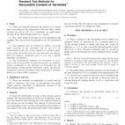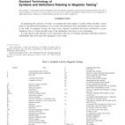No products
ASTM C1730-17
ASTM C1730-17 Standard Test Method for Particle Size Distribution of Advanced Ceramics by X-Ray Monitoring of Gravity Sedimentation
standard by ASTM International, 07/01/2017
Full Description
1.1This test method covers the determination of particle size distribution of advanced ceramic powders. Experience has shown that this test method is satisfactory for the analysis of silicon carbide, silicon nitride, and zirconium oxide in the size range of 0.1 up to 50 m.
1.1.1However, the relationship between size and sedimentation velocity used in this test method assumes that particles sediment within the laminar flow regime. It is generally accepted that particles sedimenting with a Reynolds number of 0.3 or less will do so under conditions of laminar flow with negligible error. Particle size distribution analysis for particles settling with a larger Reynolds number may be incorrect due to turbulent flow. Some materials covered by this test method may settle in water with a Reynolds number greater than 0.3 if large particles are present. The user of this test method should calculate the Reynolds number of the largest particle expected to be present in order to judge the quality of obtained results. Reynolds number (Re) can be calculated using the following equation:

| where: | ||
| D | = | the diameter of the largest particle expected to be present, in cm, |
| = | the particle density, in g/cm, | |
| 0 | = | the suspending liquid density, in g/cm, |
| g | = | the acceleration due to gravity, 981 cm/sec, and |
| = | the suspending liquid viscosity, in poise. | |
1.1.2A table of the largest particles that can be analyzed with a suggested maximum Reynolds number of 0.3 or less in water at 35C is given for a number of materials in Table 1. A column of the Reynolds number calculated for a 50-m particle sedimenting in the same liquid system is also given for each material. Larger particles can be analyzed in dispersing media with viscosities greater than that for water. Aqueous solutions of glycerine or sucrose have such higher viscosities.
| Particle Composition | Particle Density | Maximum Particle Diameter, m | Reynolds Number for 50 mA |
| Aluminum Nitride | 3.26 | 50.36 | 0.29 |
| Aluminum Oxide | 3.965 | 46.01 | 0.39 |
| Cerium Dioxide | 7.132 | 36.13 | 0.80 |
| Silicon Carbide | 3.217 | 50.68 | 0.29 |
| Silicon Nitride | 3.44 | 49.09 | 0.32 |
| Yttrium Oxide | 5.01 | 41.61 | 0.52 |
| Zirconium Oxide | 5.89 | 38.95 | 0.63 |
1.2The procedure described in this test method may be applied successfully to other ceramic powders in this general size range, provided that appropriate dispersion procedures are developed. It is the responsibility of the user to determine the applicability of this test method to other materials. Note however that some ceramics, such as boron carbide and boron nitride, may not absorb X-rays sufficiently to be characterized by this analysis method.
1.3The values stated in cgs units are to be regarded as the standard, which is the long-standing industry practice. The values given in parentheses are for information only.
1.4This standard does not purport to address all of the safety concerns, if any, associated with its use. It is the responsibility of the user of this standard to establish appropriate safety and health practices and determine the applicability of regulatory limitations prior to use. Specific hazard information is given in Section 8.
1.5This international standard was developed in accordance with internationally recognized principles on standardization established in the Decision on Principles for the Development of International Standards, Guides and Recommendations issued by the World Trade Organization Technical Barriers to Trade (TBT) Committee.


































